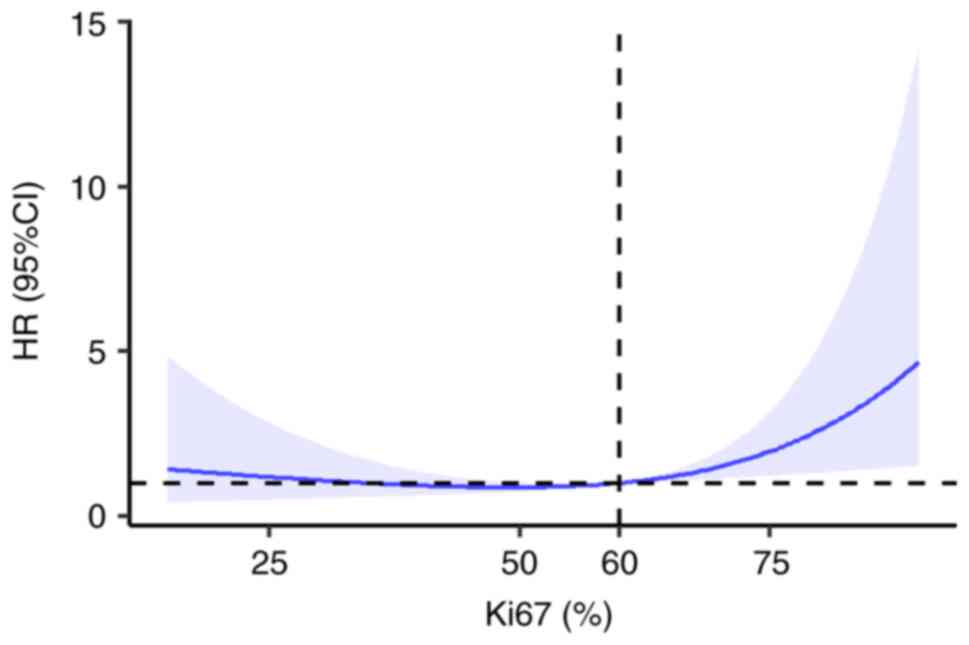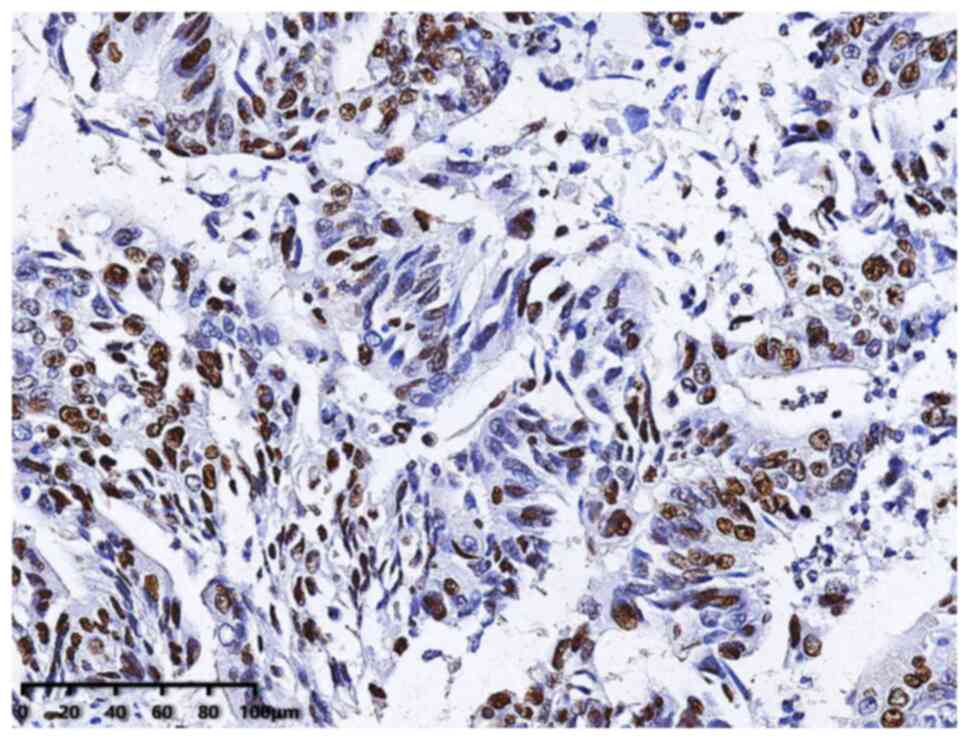|
1
|
Sung H, Ferlay J, Siegel RL, Laversanne M,
Soerjomataram I, Jemal A and Bray F: Global cancer statistics 2020:
GLOBOCAN estimates of incidence and mortality worldwide for 36
cancers in 185 countries. CA Cancer J Clin. 71:209–249. 2021.
View Article : Google Scholar : PubMed/NCBI
|
|
2
|
Arnold M, Sierra MS, Laversanne M,
Soerjomataram I, Jemal A and Bray F: Global patterns and trends in
colorectal cancer incidence and mortality. Gut. 66:683–691. 2017.
View Article : Google Scholar
|
|
3
|
Bray F, Ferlay J, Soerjomataram I, Siegel
RL, Torre LA and Jemal A: Global cancer statistics 2018: GLOBOCAN
estimates of incidence and mortality worldwide for 36 cancers in
185 countries. CA Cancer J Clin. 68:394–424. 2018. View Article : Google Scholar : PubMed/NCBI
|
|
4
|
Lortet-Tieulent J, Georges D, Bray F and
Vaccarella S: Profiling global cancer incidence and mortality by
socioeconomic development. Int J Cancer. 147:3029–3036. 2020.
View Article : Google Scholar : PubMed/NCBI
|
|
5
|
Yamamoto T, Kawada K and Obama K:
Inflammation-related biomarkers for the prediction of prognosis in
colorectal cancer patients. Int J Mol Sci. 22:80022021. View Article : Google Scholar
|
|
6
|
Dekker E, Tanis PJ, Vleugels JLA, Kasi PM
and Wallace MB: Colorectal cancer. Lancet. 394:1467–1480. 2019.
View Article : Google Scholar
|
|
7
|
Lech G, Słotwiński R, Słodkowski M and
Krasnodębski IW: Colorectal cancer tumour markers and biomarkers:
Recent therapeutic advances. World J Gastroenterol. 22:1745–1755.
2016. View Article : Google Scholar
|
|
8
|
Walker J and Quirke P: Prognosis and
response to therapy in colorectal cancer. Eur J Cancer. 38:880–886.
2002. View Article : Google Scholar : PubMed/NCBI
|
|
9
|
Mahar AL, Compton C, Halabi S, Hess KR,
Weiser MR and Groome PA: Personalizing prognosis in colorectal
cancer: A systematic review of the quality and nature of clinical
prognostic tools for survival outcomes. J Surg Oncol. 116:969–982.
2017. View Article : Google Scholar
|
|
10
|
Gerdes J, Schwab U, Lemke H and Stein H:
Production of a mouse monoclonal antibody reactive with a human
nuclear antigen associated with cell proliferation. Int J Cancer.
31:13–20. 1983. View Article : Google Scholar : PubMed/NCBI
|
|
11
|
Gerdes J, Lemke H, Baisch H, Wacker HH,
Schwab U and Stein H: Cell cycle analysis of a cell
proliferation-associated human nuclear antigen defined by the
monoclonal antibody Ki-67. J Immunol. 133:1710–1715. 1984.
|
|
12
|
Li LT, Jiang G, Chen Q and Zheng JN: Ki67
is a promising molecular target in the diagnosis of cancer
(review). Mol Med Rep. 11:1566–1572. 2015. View Article : Google Scholar : PubMed/NCBI
|
|
13
|
Menon SS, Guruvayoorappan C, Sakthivel KM
and Rasmi RR: Ki-67 protein as a tumour proliferation marker. Clin
Chim Acta. 491:39–45. 2019. View Article : Google Scholar
|
|
14
|
Fodor IK, Hutchins GG, Espiritu C, Quirke
P and Jubb AM: Prognostic and predictive significance of
proliferation in 867 colorectal cancers. J Clin Pathol. 65:989–995.
2012. View Article : Google Scholar
|
|
15
|
Li P, Xiao ZT, Braciak TA, Ou QJ, Chen G
and Oduncu FS: Association between Ki67 index and
clinicopathological features in colorectal cancer. Oncol Res Treat.
39:696–702. 2016. View Article : Google Scholar
|
|
16
|
Luo ZW, Zhu MG, Zhang ZQ, Ye FJ, Huang WH
and Luo XZ: Increased expression of Ki-67 is a poor prognostic
marker for colorectal cancer patients: A meta analysis. BMC Cancer.
19:1232019. View Article : Google Scholar : PubMed/NCBI
|
|
17
|
Ma YL, Peng JY, Zhang P, Liu WJ, Huang L
and Qin HL: Immunohistochemical analysis revealed CD34 and Ki67
protein expression as significant prognostic factors in colorectal
cancer. Med Oncol. 27:304–309. 2010. View Article : Google Scholar
|
|
18
|
Iatropoulos MJ and Williams GM:
Proliferation markers. Exp Toxicol Pathol. 48:175–181. 1996.
View Article : Google Scholar
|
|
19
|
Tong G, Zhang G, Liu J, Zheng Z, Chen Y,
Niu P and Xu X: Cut-off of 25% for Ki67 expression is a good
classification tool for prognosis in colorectal cancer in the AJCC8
stratification. Oncol Rep. 43:1187–1198. 2020.PubMed/NCBI
|
|
20
|
Miller I, Min M, Yang C, Tian C, Gookin S,
Carter D and Spencer SL: Ki67 is a graded rather than a binary
marker of proliferation versus quiescence. Cell Rep.
24:1105–1112.e5. 2018. View Article : Google Scholar : PubMed/NCBI
|
|
21
|
Salminen E, Palmu S, Vahlberg T, Roberts
PJ and Söderström KO: Increased proliferation activity measured by
immunoreactive Ki67 is associated with survival improvement in
rectal/recto sigmoid cancer. World J Gastroenterol. 11:3245–3249.
2005. View Article : Google Scholar
|
|
22
|
Dowsett M, Nielsen TO, A'Hern R, Bartlett
J, Coombes RC, Cuzick J, Ellis M, Henry NL, Hugh JC, Lively T, et
al: Assessment of Ki67 in breast cancer: Recommendations from the
international Ki67 in breast cancer working group. J Natl Cancer
Inst. 103:1656–1664. 2011. View Article : Google Scholar
|
|
23
|
Sun X and Kaufman PD: Ki-67: More than a
proliferation marker. Chromosoma. 127:175–186. 2018. View Article : Google Scholar
|
|
24
|
Scholzen T and Gerdes J: The Ki-67
protein: From the known and the unknown. J Cell Physiol.
182:311–322. 2000. View Article : Google Scholar
|
|
25
|
Graziano F and Cascinu S: Prognostic
molecular markers for planning adjuvant chemotherapy trials in
Dukes' B colorectal cancer patients: How much evidence is enough?
Ann Oncol. 14:1026–1038. 2003. View Article : Google Scholar
|
|
26
|
Torén W, Ansari D and Andersson R:
Immunohistochemical investigation of prognostic biomarkers in
resected colorectal liver metastases: A systematic review and
meta-analysis. Cancer Cell Int. 18:2172018. View Article : Google Scholar
|
|
27
|
Weber JC, Nakano H, Bachellier P,
Oussoultzoglou E, Inoue K, Shimura H, Wolf P, Chenard-Neu MP and
Jaeck D: Is a proliferation index of cancer cells a reliable
prognostic factor after hepatectomy in patients with colorectal
liver metastases? Am J Surg. 182:81–88. 2001. View Article : Google Scholar : PubMed/NCBI
|
|
28
|
Wang L, Liu Z, Fisher KW, Ren F, Lv J,
Davidson DD, Baldridge LA, Du X and Cheng L: Prognostic value of
programmed death ligand 1, p53, and Ki-67 in patients with
advanced-stage colorectal cancer. Hum Pathol. 71:20–29. 2018.
View Article : Google Scholar
|
|
29
|
Ishida H, Miwa H, Tatsuta M, Masutani S,
Imamura H, Shimizu J, Ezumi K, Kato H, Kawasaki T, Furukawa H and
Kawakami H: Ki-67 and CEA expression as prognostic markers in
Dukes' C colorectal cancer. Cancer Lett. 207:109–115. 2004.
View Article : Google Scholar
|
|
30
|
Dawson H, Koelzer VH, Karamitopoulou E,
Economou M, Hammer C, Muller DE, Lugli A and Zlobec I: The
apoptotic and proliferation rate of tumour budding cells in
colorectal cancer outlines a heterogeneous population of cells with
various impacts on clinical outcome. Histopathology. 64:577–584.
2014. View Article : Google Scholar : PubMed/NCBI
|
|
31
|
Fernández-Cebrián JM, Santos MN, Kuborn
PV, de Lama MP, Martín-Cavanna J, Martínez PP, Escudero BF and
Fernández MR: Can the clinical outcome in stage II colon carcinomas
be predicted by determination of molecular marker expression? Clin
Transl Oncol. 9:663–670. 2007. View Article : Google Scholar
|
|
32
|
Wu XS, Xi HQ and Chen L: Lgr5 is a
potential marker of colorectal carcinoma stem cells that correlates
with patient survival. World J Surg Oncol. 10:2442012. View Article : Google Scholar
|
|
33
|
Melling N, Kowitz CM, Simon R, Bokemeyer
C, Terracciano L, Sauter G, Izbicki JR and Marx AH: High Ki67
expression is an independent good prognostic marker in colorectal
cancer. J Clin Pathol. 69:209–214. 2016. View Article : Google Scholar
|
|
34
|
Wei DM, Chen WJ, Meng RM, Zhao N, Zhang
XY, Liao DY and Chen G: Augmented expression of Ki-67 is correlated
with clinicopathological characteristics and prognosis for lung
cancer patients: An up-dated systematic review and meta-analysis
with 108 studies and 14,732 patients. Respir Res. 19:1502018.
View Article : Google Scholar : PubMed/NCBI
|
|
35
|
Nielsen TO, Leung SCY, Rimm DL, Dodson A,
Acs B, Badve S, Denkert C, Ellis MJ, Fineberg S, Flowers M, et al:
Assessment of Ki67 in breast cancer: Updated recommendations from
the international Ki67 in breast cancer working group. J Natl
Cancer Inst. 113:808–819. 2021. View Article : Google Scholar
|
|
36
|
Ajani JA, Wang X, Izzo JG, Crane CH, Eng
C, Skibber JM, Das P and Rashid A: Molecular biomarkers correlate
with disease-free survival in patients with anal canal carcinoma
treated with chemoradiation. Dig Dis Sci. 55:1098–1105. 2010.
View Article : Google Scholar
|
|
37
|
Nash GM, Gimbel M, Shia J, Nathanson DR,
Ndubuisi MI, Zeng ZS, Kemeny N and Paty PB: KRAS mutation
correlates with accelerated metastatic progression in patients with
colorectal liver metastases. Ann Surg Oncol. 17:572–578. 2010.
View Article : Google Scholar
|
|
38
|
Shin IY, Sung NY, Lee YS, Kwon TS, Si Y,
Lee YS, Oh ST and Lee IK: The expression of multiple proteins as
prognostic factors in colorectal cancer: Cathepsin D, p53, COX-2,
epidermal growth factor receptor, C-erbB-2, and Ki-67. Gut Liver.
8:13–23. 2014. View Article : Google Scholar : PubMed/NCBI
|
|
39
|
Ivanecz A, Kavalar R, Palfy M, Pivec V,
Sremec M, Horvat M and Potrč S: Can we improve the clinical risk
score? The prognostic value of p53, Ki-67 and thymidylate synthase
in patients undergoing radical resection of colorectal liver
metastases. HPB (Oxford). 16:235–242. 2014. View Article : Google Scholar : PubMed/NCBI
|
|
40
|
Seigneurin D and Guillaud P: Ki-67
antigen, a cell cycle and tumor growth marker. Pathol Biol (Paris).
39:1020–1028. 1991.(In French). PubMed/NCBI
|
|
41
|
Desquilbet L and Mariotti F: Dose-response
analyses using restricted cubic spline functions in public health
research. Stat Med. 29:1037–1057. 2010.PubMed/NCBI
|
|
42
|
Ramesh AN, Kambhampati C, Monson JR and
Drew PJ: Artificial intelligence in medicine. Ann R Coll Surg Engl.
86:334–338. 2004. View Article : Google Scholar
|
|
43
|
Hamet P and Tremblay J: Artificial
intelligence in medicine. Metabolism. 69s:S36–S40. 2017. View Article : Google Scholar : PubMed/NCBI
|
















